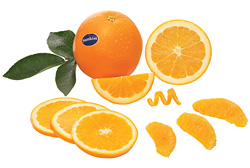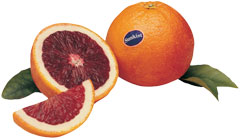Navel Oranges
Sunkist navel oranges are available from November through May, with peak supplies in January, February and March. Navel oranges are easy to spot in your produce aisle. They're the ones with the button formation opposite the stem end. Considered the world's finest orange for eating, navels are seedless, and they peel and segment easily.
Navel Orange Tips
- For the best nutritional value and taste, juice only enough navel oranges to drink and enjoy right away!
- Navel orange segments are healthy and fun kid foods for snacks and lunches, that pack and travel well. Peel the orange, then gently separate the fruit along the natural divisions.
- Try this guilt-free treat: cut navel orange segments into low- or nonfat chocolate yogurt.
- Toss some navel orange sections on your favorite cereal, pancakes and waffles.
Valencia Oranges
Endless Summer
Sunkist Valencia oranges-often called summer oranges-are actually available from February through October, with peak supplies in May, June and July. Valencia oranges are small to medium sized, and they may have a few seeds. They are usually thin-skinned.
Valencia Orange Tips
- Fresh Valencia juice may be squeezed and refrigerated overnight. If tightly covered and immediately chilled, no loss of flavor or Vitamin C will occur
- Fresh juice packs nutritional power and great taste into all kinds of fruit smoothies. Start with 1/2 cup of juice and 1/2 cup of diced orange in a blender. Add a peeled banana, some frozen berries and 1/2 cup of yogurt. Your body will thank you!
- Say "Valencia!" Valencias especially good to eat when cut into "smiles." Cut fruit in half crosswise; then cut 3 or 4 wedges from each half.
- Peeling Valencias is easy: trim a thin slice from each end of the fruit, then set orange on one end. Cut away strips of peel from top to bottom, until all peel is removed.
Moro (Blood) Oranges
Moro oranges are available from January through mid April. Moros are small to medium sized with a thin skin and few or no seeds. Slice open a Moro and you'll see a dramatic and beautiful bright red to deep maroon interior. Take a bite and you'll become a fan of the intense orange taste that hints of fresh raspberry.
As nights get cooler, the Moro's exterior blush intensifies.
Juicy Fact
All oranges contain carotene — that's what makes them orange. Moros get their red color from high concentrations of a pigment called anthocyanin, a powerful antioxidant that neutralizes the effects of free radicals. Free radicals are the agents believed to be responsible for cancer, aging and other health ailments.
Moro Orange Tips
- Enjoy Moros out of hand, use them for an interesting juice or showcase their jewel-like color in recipes.
- Toss slices or segments into salads, salsas and chutneys.
- The intense flavor of Moro oranges is wonderful with roasted or grilled meat and poultry.
- Melt a couple of tablespoons of orange marmalade in the microwave and tumble in one peeled, diced Moro orange for a quick and exotic sauce.
Cara Cara Oranges
Cara Cara oranges, a type of navel grown in California's San Joaquin Valley, are available January through April. Their outward appearance is similar to other navels, but their interior is a distinctive pinkish red and has an exceptionally sweet flavor with a tangy cranberry-like zing. Cara Caras are a rich source of Vitamins A and C, fiber and Lycopene. A perfect snack served as wedges, they're also a colorful addition to beverages or squeezed into a vinaigrette salad dressing.
Courtesy of Sunkist, 2010
